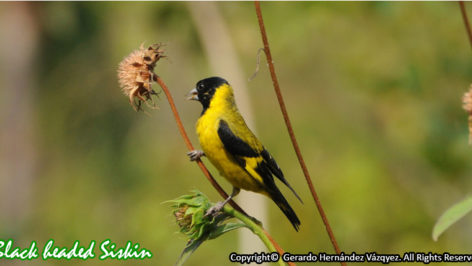San Sebastian del Oeste
 Private guided birding tour for you and your group to San Sebastian del Oeste, -endemics to the mountains of Western México. We will pick you up at your hotel or private villa in the Puerto Vallarta area at 6:00 a.m. Then we’ll drive for about 2 hours to San Sebastian del Oeste, located in the West Sierra Madre Mountains, from there we will drive to La Bufa, the natural habitat of some of the endemic birds of México´s highlands: Magnificent Hummingbird (Eugenes fulgens), Bumblebee Hummingbird (Selasphorus heloisa), White-eared Hummingbird (Basilinna leucotis), White-striped Woodcreeper (Lepidocolaptes leucogaster), Transvolcanic Jay (Aphelacoma ultramarina), Spotted Wren (Campylorhynchus gularis), Brown- Backed Solitaire (Myadestes occidentalis), Blue Mockingbird (Malanotis caerulescens), Golden Vireo (Vireo hypochryseus) Red-headed Tanager (Spermagra erythrocephala), Rufous-capped Warbler (Basileuterus rufifrons), Rufous-capped Brush-finch (Atlapetes pileatus), Black-headed Siskin (Carduelis notata forreri), Collared Towhee (Pipilo ocai alticola), Rustic-crowned Ground-Sparrow (Melozone kieneri).
Private guided birding tour for you and your group to San Sebastian del Oeste, -endemics to the mountains of Western México. We will pick you up at your hotel or private villa in the Puerto Vallarta area at 6:00 a.m. Then we’ll drive for about 2 hours to San Sebastian del Oeste, located in the West Sierra Madre Mountains, from there we will drive to La Bufa, the natural habitat of some of the endemic birds of México´s highlands: Magnificent Hummingbird (Eugenes fulgens), Bumblebee Hummingbird (Selasphorus heloisa), White-eared Hummingbird (Basilinna leucotis), White-striped Woodcreeper (Lepidocolaptes leucogaster), Transvolcanic Jay (Aphelacoma ultramarina), Spotted Wren (Campylorhynchus gularis), Brown- Backed Solitaire (Myadestes occidentalis), Blue Mockingbird (Malanotis caerulescens), Golden Vireo (Vireo hypochryseus) Red-headed Tanager (Spermagra erythrocephala), Rufous-capped Warbler (Basileuterus rufifrons), Rufous-capped Brush-finch (Atlapetes pileatus), Black-headed Siskin (Carduelis notata forreri), Collared Towhee (Pipilo ocai alticola), Rustic-crowned Ground-Sparrow (Melozone kieneri).
The scenery changes dramatically as you leave the Valley of Banderas on the way to the West Sierra Madre Mountains. Temperature also drops a few degrees as you drive up the mountains. There is a rapid ascension from sea level to 1,480 meters above sea level. You can clearly perceive how the tropical forest is left behind to give way to the sub deciduous mixed forest, only to see it replaced with the pine-oak forest soon after.
Tropical Mountain Cloud Forests are the most threatened ecosystems on a national level. They are of great importance due to the extraordinary biodiversity they support and the hydrological services they provide.
San Sebastian del Oeste is a town of approximately 600 inhabitants. Its main attractions are its colonial architecture, the San Sebastian parish dating from 1608, and the adjacent small archaeology and history museum.
8-hour birding tour.
bird list:
Turkey Vulture, Black Vulture, Red-tailed Hawk, Grey Hawk, Rufous-bellied Chachalaca, Squirrel Cuckoo, Groove-billed Ani, Band-tailed Pigeon, Sinaloa Martin, White-eared Hummingbird, Berylline Hummingbird, Magnificent Hummingbird, Black-Chined Hummingbird, Rufous Hummingbird, Calliope Hummingbird, Bumblebee Hummingbird, Mountain Trogon, Acorn Woodpecker, Ladder-backed Woodpecker, Northern Flicker, White-striped Woodcreeper, Pine Flycatcher, Tufted Flycatcher, Greater Pewee, Social Flycatcher, Sulphur-bellied Flycatcher, Black-throated Magpie-Jay, Green Jay, San Blas Jay, Transvolcanic Jay, Spotted Wren, Happy Wren, Brown-throated Wren, White-throated Robin, Brown-Backed Solitaire, Orange-billed Nightingale-Thrush, Russet Nightingale Thrush,
Blue Mockingbird, Grey Silky Flycatcher, Nashville Warbler, Cresent-chested Warbler, Yellow-rumped Warbler, Townsend´s Warbler, Hermit Warbler, Grace´s Warbler, Black and White Warbler, Wilson´s Warbler, Red-faced Warbler
Painted Redstart, Slate-throated Redstart, Elegant Euphonia, Rufous-Capped Warbler, Golden-browed Warbler, Hepatic Tanager, Red-headed Tanager, Greyish Saltator, Black-headed Siskin, Black-headed Grosbeak, Varied Bunting,
Rufous-capped brushfinch, Rusty-crowed Ground-Sparrow, Collared Towhee, Stripe-Headed Sparrow, Yellow-eyed Junco, Bronzed Cowbird, Yellow-winged Cacique, Hooded Oriole, Audobon´s Oriole, Bullocks Oriole.